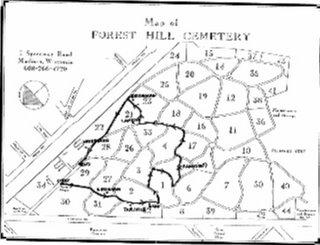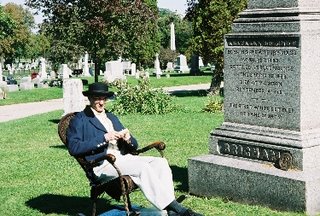Part 1: Intro
Part 2: The Tour Continues
Part 3: Confederate Rest & Soldiers Lot
~~~~~~~~~~~~~~~~~~~~~~~~~~~~~~~~~~~

Map of this year's tour
One of my favorite fall events in Madison is the annual “Talking Spirits” tour through historic Forest Hill Cemetery. During the two-hour tour, visitors meet a half dozen “spirits” – some of Madison’s most prominent sons and daughters – and hear their fascinating stories. Presented by the Wisconsin Veterans Museum, the event focuses on a different conflict each year, with this year’s emphasis being on the Civil War – also known as the War Between the States. I've copied this year's map so that you can follow the path we took through the cemetery, beginning near number 34 and ending near number 29. Though we only traversed half the cemetery, it was a meandering route and not at all flat.
As is customary, the tour began at Catlin Chapel, where the director of the WVM shared information about the museum and cemetery, then introduced our guide and we were on our way.
We started towards the first stop on the tour, our guide pointing out some of the different aspects of cemetery architecture, as well as a few stones belonging to prominent Madisonians: the large silver sphere of Tenney, the tall and overly pretentious obelisk of Henry Vilas, the plot owned by the Shipman family – Stephen Shipman having been a great architect who built many of the early buildings in Madison and who literally helped rebuild Chicago after the Great Fire. At last we came to the first spirit of this year’s tour, Ebenezer Brigham (portrayed by John Eichenlaub), who “politely” instructed us to move along up the road as he was “there first.” Silence, as he went back to his whittling, then realizing we were still there, he relented to tell us about himself. Brigham was indeed here first — or at least, he was the first permanent white settler of Dane County. He came west to St. Louis where lead was reported to be found, moved to Galena, IL, and then north to what is now Blue Mounds, where he struck the mother lode. Native Americans were also mining the hills, though their tools and methods were much more primitive, and left Brigham to his own. However, word soon spread of his bounty and miners quickly swarmed north.
At last we came to the first spirit of this year’s tour, Ebenezer Brigham (portrayed by John Eichenlaub), who “politely” instructed us to move along up the road as he was “there first.” Silence, as he went back to his whittling, then realizing we were still there, he relented to tell us about himself. Brigham was indeed here first — or at least, he was the first permanent white settler of Dane County. He came west to St. Louis where lead was reported to be found, moved to Galena, IL, and then north to what is now Blue Mounds, where he struck the mother lode. Native Americans were also mining the hills, though their tools and methods were much more primitive, and left Brigham to his own. However, word soon spread of his bounty and miners quickly swarmed north.
Recognizing an opportunity when he saw one, Brigham opened a store for the prospectors, regularly traveling down to Galena or up to Green Bay for more supplies. It was during one of his supply trips up to Fort Winnebago that he camped on a beautiful isthmus nestled between two pristine lakes. So taken was he by the sunrise over the eastern lake the next morning that he later remarked it was at that moment he knew great city would one day be built there. A year later he met a surveyor by the name of James Doty and told him of the narrow spit of land rising between the lakes. Doty traveled to the spot and was so taken with it that he purchased 12 acres for $1500 and named his new city after President James Madison. Both a street and a park bear the Madison name as well. Brigham served on the first Territorial Council and in 1836 pushed to make Madison the state capitol. He served until 1842, and later served a term in the assembly. He was a veteran of both the Red Bird uprising of 1827 and Black Hawk War of 1832. He died in 1861. Providing a panoramic view of the Wisconsin River Valley, Brigham County Park near Blue Mounds was named in his honor.
A year later he met a surveyor by the name of James Doty and told him of the narrow spit of land rising between the lakes. Doty traveled to the spot and was so taken with it that he purchased 12 acres for $1500 and named his new city after President James Madison. Both a street and a park bear the Madison name as well. Brigham served on the first Territorial Council and in 1836 pushed to make Madison the state capitol. He served until 1842, and later served a term in the assembly. He was a veteran of both the Red Bird uprising of 1827 and Black Hawk War of 1832. He died in 1861. Providing a panoramic view of the Wisconsin River Valley, Brigham County Park near Blue Mounds was named in his honor.





No comments:
Post a Comment